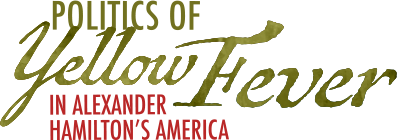Class 3: Race, Class, and Citizenship During Yellow Fever Response
Introduction:
This class pivots away from scientific and political discourse to the labor required to respond to an epidemic. As the epidemic raged, local government collapsed. The city’s African American community provided essential relief services, working as nurses, grave diggers, porters, and more. The primary and secondary sources cover the African American community’s outsized role in yellow fever response, including how African Americans used their labor to justify inclusion in civic life. Students investigate how prominent African Americans actively challenged white authors’ racist assumptions in the reports of their efforts.
Class Resources
Readings
Secondary Sources
Secondary Sources
- Miller, Jacquelyn C. “The Wages of Blackness: African American Workers and the Meanings of Race during Philadelphia’s 1793 Yellow Fever Epidemic.” The Pennsylvania Magazine of History and Biography 129, no. 2 (April 2005): 163–94.
- Will, Thomas E. “Liberalism, Republicanism, and Philadelphia’s Black Elite in the Early Republic: The Social Thought of Absalom Jones and Richard Allen.” Pennsylvania History 69, no. 4 (Autumn 2002): 558–76.
- Carey, Mathew. A Short Account of the Malignant Fever, Lately Prevalent in Philadelphia: With a Statement of the Proceedings That Took Place on the Subject in Different Parts of the United States. Philadelphia: Printed by the author, 1793. pp. 71–78. From U.S. National Library of Medicine: Digital Collections. http://resource.nlm.nih.gov/8710344
- Jones, Absalom, and Richard Allen. A Narrative of the Proceedings of the Black People, during the Late Awful Calamity in Philadelphia, in the Year 1793: And a Refutation of Some Censures, Thrown upon Them in Some Late Publications. Philadelphia, PA: William W. Woodward, 1794. From U.S. National Library of Medicine: Digital Collections. http://resource.nlm.nih.gov/2559020R
- Peale, Raphaelle. Absalom Jones. 1810. Oil on paper mounted to board. Delaware Art Museum
- Richard Allen, Bishop of the First African Methodist Episcopal Church. n.d. Schomburg Center for Research in Black Culture, Photographs and Prints Division, The New York Public Library
Discussion Questions
- Why does Thomas Will say that “everything seemed up for grabs, especially for African Americans, as the yellow fever descended upon Philadelphia” (p. 560)?
- What do liberalism and republicanism mean in the context of Will’s article? How does this align with the use of “republican” by men like Rush that were discussed in previous sessions?
- What were the political, social, and economic factors that contributed to African American’s outsized role in epidemic response?
- To whom did Jones and Allen address their A Narrative…? What kind of evidence do they marshal to their case? How do Jones and Allen explain the “exorbitant wages” paid to some nurses?
- What is the “civic man” in Jones and Allen’s thought (see Will, p. 561)? Point to specific examples in their book where they invoke this idea.
- On page 8, Jones and Allen acknowledge that, “there were some few black people guilty of plundering the distressed” but note that, “we know as many whites who were guilty of it; but this is looked over, while the blacks are held up to censure. Is it a greater crime for a black to pilfer, than for a white to privateer?” How are “pilfer” and “privateer” used strategically here? What are they implying about black and white “plundering” during the epidemic?
- Why do Jones and Allen take issue with Carey’s naming some African Americans who did excellent work during the epidemic? How do Jones and Allen align themselves with all African American residents of Philadelphia?
- Why do you think Allen and Jones closed their account with a proverb (p. 20)? How do you interpret it in relationship to the rest of A Narrative…?
- Each of the short pieces at the end of A Narrative… address slavery and abolition in some way but do not speak directly to yellow fever or the African American response to the epidemic. Why are the documents here? How is the case for abolition made stronger by the preceding account of yellow fever response?
- How do you see these social dynamics in contemporary epidemics? What has and has not changed since 1793?






